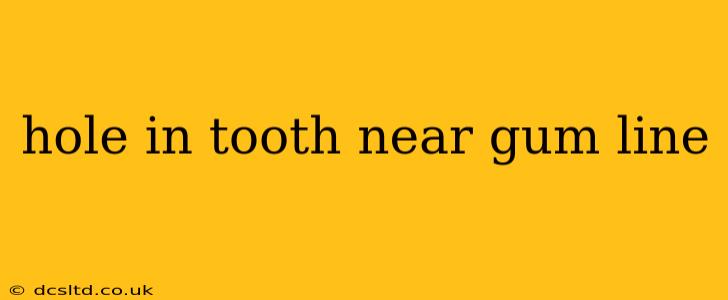A hole in your tooth near the gum line, often called a cavity or caries, is a common dental problem that requires prompt attention. Ignoring it can lead to more serious issues like gum disease, tooth abscesses, and even tooth loss. This comprehensive guide will explore the causes, treatment options, and preventive measures for this concerning dental condition.
What Causes a Hole in a Tooth Near the Gum Line?
The primary culprit behind tooth decay, including holes near the gum line, is tooth decay, caused by bacteria. These bacteria thrive on sugar and carbohydrates, producing acids that erode tooth enamel. Over time, this erosion creates a cavity, which appears as a hole. The gum line is a particularly vulnerable area because it's often harder to clean thoroughly, allowing bacteria to accumulate.
Other contributing factors include:
- Poor oral hygiene: Insufficient brushing and flossing allow plaque and bacteria to build up, increasing the risk of decay.
- Diet: A diet high in sugary and acidic foods and drinks fuels the bacteria responsible for tooth decay.
- Dry mouth: Saliva helps neutralize acids and wash away food particles. Dry mouth, caused by certain medications or medical conditions, increases susceptibility to cavities.
- Genetics: Some individuals are genetically predisposed to developing cavities more easily.
- Existing dental work: The edges of old fillings or crowns can trap food particles and bacteria, leading to decay.
- Gum recession: As gums recede, more of the tooth root is exposed, making it more vulnerable to decay.
How is a Hole in a Tooth Near the Gum Line Treated?
Treatment for a hole near the gum line depends on the size and severity of the cavity. Your dentist will determine the best course of action after a thorough examination. Options include:
- Fillings: For smaller cavities, a filling is typically used to restore the damaged tooth structure. Materials like composite resin, porcelain, or amalgam are commonly employed.
- Inlays/Onlays: These are indirect restorations, meaning they are crafted in a dental lab and then cemented onto the tooth. They are used for larger cavities than fillings can effectively address.
- Crowns: If the cavity is extensive, a crown might be necessary to protect the remaining tooth structure and restore its function and aesthetics.
- Root canal treatment: If the decay has reached the tooth's pulp (the inner part containing nerves and blood vessels), a root canal is required to remove the infected tissue and prevent further damage. This is often followed by a crown.
- Extraction: In severe cases where the tooth is beyond repair, extraction (removal) may be the only option.
What are the Signs of a Hole in a Tooth Near the Gum Line?
Recognizing the signs early is crucial for effective treatment and preventing further complications. Watch out for:
- Toothache: Pain, sensitivity to hot or cold, or lingering discomfort.
- Discoloration: A dark spot or stain on the tooth's surface.
- Sensitivity: Increased sensitivity to touch or pressure.
- Visible hole or pit: A noticeable cavity in the tooth structure.
- Bad breath: Persistent bad breath could indicate underlying dental issues, including decay.
- Swelling or tenderness in the gums: This could signal an infection related to the cavity.
Can a Hole in a Tooth Near the Gum Line Be Prevented?
Yes, practicing good oral hygiene is the cornerstone of preventing cavities. Here are some key preventive measures:
- Brush twice a day: Use fluoride toothpaste and a soft-bristled toothbrush. Pay special attention to the gum line.
- Floss daily: Flossing removes food particles and plaque from between your teeth, where your toothbrush can't reach.
- Use mouthwash: An antimicrobial mouthwash can help reduce bacteria in your mouth.
- Limit sugary and acidic foods and drinks: Reduce your intake of sugary snacks, candies, and sodas.
- Regular dental checkups and cleanings: Schedule professional cleanings and examinations at least twice a year. This allows your dentist to detect and treat cavities early, before they become significant problems.
How Much Does Treatment for a Hole in a Tooth Near the Gum Line Cost?
The cost of treatment varies greatly depending on the extent of the damage, the chosen treatment method, and your location. It's best to consult with your dentist for a personalized cost estimate. Insurance coverage can significantly impact the final cost.
Remember, early detection and treatment are essential. Don't hesitate to schedule an appointment with your dentist if you suspect you have a hole in your tooth near the gum line. Prevention is key, but professional care is crucial for maintaining oral health.
